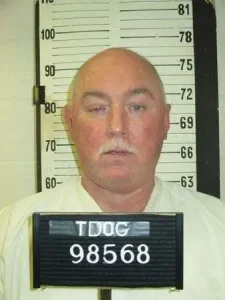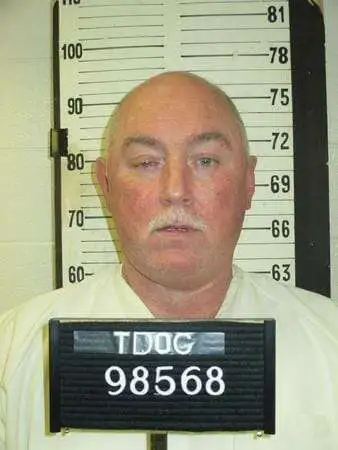John Bane was sentenced to death by the State of Tennessee for the murder of Royce Frazier
According to court documents Royce Frazier was found dead in a bathtub, he had been gagged, a bag was placed over his head and an electrical cord was wrapped around his throat. John Bane used a toilet plunger to keep Royce head under the water.
After murdering Royce Frazier John Bane would ransack his home and stealing everything that was not nailed down
John Bane would be arrested, convicted and sentenced to death
John Bane Photos

John Bane FAQ
Where Is John Bane Now
John Bane is incarcerated at Riverbend Maximum Security Institution
John Bane Case
On November 19, 1988, police found the body of the victim, Royce D. Frazier, age 60, lying in a bathtub full of water in his home near Memphis, Tennessee. Frazier had been gagged; a plastic bag had been placed over his head; and an electrical cord was tied around his neck. A plunger had been placed over his face apparently to keep his head submerged. Frazier’s house had been ransacked: several lamps and ashtrays had been overturned and numerous items were scattered in disarray.
Brian Lovett, who was 16 at the time of the offense, testified that his mother, Donna Lovett, and the defendant, John Michael Bane, had discussed a plan to rob the victim several days before he was killed. The plan was for Donna Lovett to visit Frazier, whom she knew, and render him unconscious by putting Visine eye drops in his beer. Bane would then enter Frazier’s home and carry out the robbery with Donna Lovett. According to Brian Lovett, Bane said that Frazier would have to be killed because he “knew [Lovett] and would tell on her.” Brian Lovett said that he and Bane discussed choking or stabbing the victim.
On the day after the robbery plan discussion, Donna Lovett and the defendant John Bane experimented by giving Brian Lovett a beer containing eye drops to see whether it would render him unconscious. Brian Lovett testified that it caused him to fall asleep within five minutes of drinking the beer. Thomas Lovett, Brian’s younger brother, also testified that he recalled Brian drinking a beer containing eye drops.
Sometime in the late afternoon of November 17, 1988, John Bane, accompanied by Donna Lovett and her two sons, Brian and Thomas Lovett, drove his car past Frazier’s home several times, but no one appeared to be home. Bane explained that he was going to borrow money from the occupant. When they saw Frazier’s car at the home, Donna Lovett got out of the car and went into the house alone. Bane then left and drove Brian and Thomas to Brian’s girlfriend’s home. A short time later, Bane picked up the boys and took them to the Lovetts’ trailer in Ripley, Tennessee. Thereafter, Bane, along with Brian Lovett, returned to Frazier’s home. When Donna Lovett signaled by “flickering” the porch light on two occasions, Bane entered Frazier’s home, leaving Brian Lovett in the car.
According to Brian Lovett’s testimony, approximately thirty minutes later John Bane and Donna Lovett ran to the car carrying several items of Frazier’s property. Bane had blood on his gloves and Donna Lovett was crying and upset. While driving from the scene, Bane told Brian that he had beaten the victim several times because he kept getting up and that he had “cut [the victim’s] nuts off.” Bane also said that he had taken $726 and that he “had done such a good job he deserved a beer.” Bane was arrested two days later when Donna Lovett reported the events of November 17, 1988 to the police.2
Brian Lovett testified that his sister committed suicide several months before the killing of the victim and that he himself had attempted suicide on two occasions before November 17, 1988. He admitted that he had been treated at Charter Lakeside and Memphis Mental Health Institute and that he had a history of using cocaine, speed, marijuana, and alcohol. Lovett also admitted that he had made conflicting statements about the murder. In one statement, he had told authorities that he had looked in Frazier’s window and saw Bane holding a knife to the victim’s groin while Donna Lovett placed a bag over the victim’s head. He did not recall why he had made the statement and conceded that he had never left Bane’s car. Lovett testified that he had been arrested for theft after Bane was convicted and that he had been placed in the same prison cell as the defendant. He conceded that he signed a statement that he had lied at trial because he feared the defendant.
Dr. Jerry Francisco, Shelby Counter Medical Examiner, testified that the cause of the victim’s death was ligature strangulation with asphyxia. The combination of the cloth gag, plastic bag, and electrical cord had cut off the supply of blood to the victim’s brain and the supply of oxygen to his lungs. The victim’s tongue had been pushed into the back of his mouth from the cloth gag. Dr. Francisco stated that the victim could have been rendered unconscious in seconds or minutes, depending on the severity and force of the ligature strangulation, but that the victim’s death required several minutes. Dr. Francisco testified that the victim had extensive bruising around his eyes, head, neck, arms, and hip; a tear and scrape below his left eye; and abrasions around his neck. There was no evidence of injury to the victim’s groin area or scrotum. Dr. Francisco testified that fluid found in the victim’s lungs was consistent with a finding that the victim had been alive when placed in the water.
The defendant John Bane called several witnesses to testify on his behalf. Brian Lovett identified the handwriting of Donna Lovett in two letters that she had written to Bane after the murder. One of the letters indicated that Brian Lovett had lied at trial and was coerced by the prosecution. Donna Lovett also wrote that only she and Bane knew what happened in Frazier’s home.
Wilma McNeill, the defendant’s aunt, testified that Bane had been “very close” to his mother, who died of cancer in April of 1988. McNeill testified that Bane had grown up working on a farm. She stated that she loved Bane and asked the jury to spare his life. Maybelle Cunningham, also an aunt of the defendant, testified that both of Bane’s parents were deceased. Cunningham testified that Bane had two sons, ages 14 and 10.
Marvin Ramey testified that Bane had worked on his farm when he was young and was a good worker. Ramey testified that his wife looked after Bane and that he had never caused any trouble.
Teresa Goforth, a co-worker of John Bane and Donna Lovett at J.P.W. Enterprises, testified that Bane was a good, hard worker. She testified that Bane and Donna Lovett were dating and that Lovett was extremely jealous. About one week before the murder, Donna Lovett told Goforth that “if she couldn’t have [the defendant], no one would and that she would see him locked away so far he would never get out.”
Alicia Shadell Gray, Bane’s cousin, likewise testified that Donna Lovett was very possessive and jealous. Three weeks before the murder, Gray heard Lovett say, “If I can’t have Michael, no woman would have Michael, and I’ll see us both behind bars.” Donna Lovett attempted suicide later that day at Gray’s home by overdosing on pills, and Bane took her to the emergency room. Gray testified that after Bane was convicted, Brian Lovett told her that his mother had agreed to plead guilty in exchange for a sentence of 35 years and that he did not want to see “an innocent man” go to prison. He said he planned to write an affidavit stating that Bane had no part in the offense.
Diane Bane testified that she met John Bane while he was in prison and fell in love with him after talking regularly to him on the telephone. She married Bane in March of 1995 and travels 200 miles round trip every Saturday to visit him. Her former husband died in August of 1994, and she had three sons from that marriage.
After deliberating on all of the above evidence, the jury found that there was evidence supporting two aggravating circumstances: (1) that the murder was “especially atrocious or cruel in that it involved torture and depravity of mind” 3 and (2) that the murder was “committed for the purpose of avoiding, interfering with or preventing a lawful arrest or prosecution of the defendant or another.” Tenn.Code Ann. § 39-2-203(i)(5), (6) (1982).4 After further finding that the aggravating circumstances outweighed the evidence of mitigating circumstances, the jury imposed a sentence of death.
